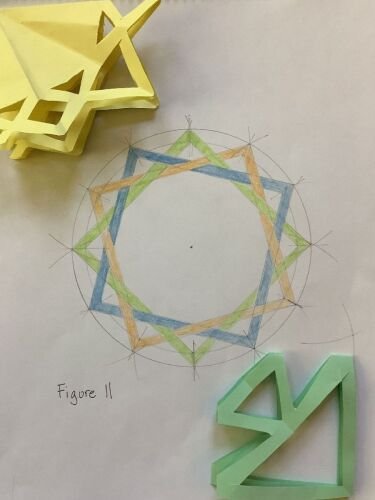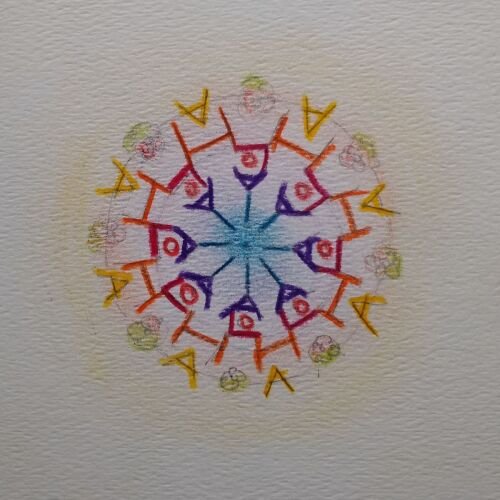“A Cheat Sheet” to Steiner’s Six Basic Exercises
by Sarah Barrett
In the Foundations teacher training, teachers are introduced to Steiner’s Six Basic Exercises. In a nutshell, these are recommended daily practices to free yourself from all the things that influence your behaviors and reactions in a negative way – impulses, jealousy, fear, things grown-ups said to you when you were a child, your own past experiences, social media, etc.
Charcoal drawing by Lotus & Ivy 7th Grade Student
Have you ever noticed yourself reacting on impulse in a way that you wish you hadn’t? Or do you sometimes catch yourself doing something the same way grown-ups did it when you were young, but maybe there is a better way? Maybe your child says/does something and it triggers you to react in less than admirable ways.
Rudolf Steiner said, “Receive the children in reverence, educate them in love, and send them forth in freedom.” What does it mean to send them forth in freedom? It means to help them come into their authentic selves, not influenced by bias, impulse, beliefs of other people, etc.
As parents and teachers, it starts with freeing ourselves. What would you be doing today if you lived in total freedom from your negative beliefs, past experiences, impulses? How can you break the cycle? I am inspired by the quote from an unknown person, “An awakened human spirit working collectively with others can change the world. The possibilities are extraordinary.”
Needle-felted dragon by Lotus & ivy 5th Grade Student
As Waldorf educators and homeschool families, we can change the world when we come into our authentic selves and help our students do the same. Living in authenticity means living out our gifts to our fullest potential, in love and service to ourselves, our families, and to our world.
These are the six exercises in the form of a brief “cheat sheet” that Steiner gave for helping one find freedom from these negative default behaviors.
Control of Thoughts
Have you ever tried to meditate but find your mind wandering to to-do lists? This first exercise is designed to help strengthen our meditative work by practicing controlling our thoughts. This practice also promotes objectivity, so our thoughts are not based solely on our own subjective experiences, beliefs, or habits.
Start by spending two minutes thinking about an object that is boring to you, like a paperclip or a staple. Once you can easily spend two minutes thinking about the paperclip, add another minute until you can do this for five minutes each day. Think about the physical qualities and history of that object. Controlling your thoughts so that you are thinking about something meaningless, like a paperclip, strengthens your capacity for choosing higher thoughts. An angry thought has a different impact than a loving thought so strengthening your capacity to choose a loving thought is powerful.
Control of Actions
Do you ever feel like your to-do list controls you and not the other way around? Or perhaps your past experiences or your upbringing have more control over you than you think. This exercise calls on us to start small by setting an intention to do one small action each day, gradually adding to it. The key to showing you are in control of your actions is to make this small action “meaningless” – like turning your ring 360 degrees around your finger at 12:30pm. Wake up in the morning and give yourself the command, “Today at 12:30pm, I am going to…” What usually happens is we forget to do it. Once you have mastered fulfilling your command for yourself, add another command.
As we practice control of our actions, we strengthen our capacities to act from a place of our choosing – perhaps acting from a place of compassion and love for one another, not from a place of stress, worry, fear, or anger.
Chalkboard drawing by Lotus & Ivy First Grade Teacher, Ms. Jones-Schmidt
Equanimity (Control of Feelings)
Practicing the control of feelings each day leads to inner tranquility and calm emotional responses. We are not to be overcome by a feeling of anger, anxiety, sorrow, or even joy. We still must feel these things deeply; however, we control our expression of these emotions. Steiner said that practicing control of feelings does not dull our feelings, but even has an opposite effect because we are now giving ourselves permission to express this emotion and we are in control of how we respond. Instead of being the victim of our emotions, we have control and are hence more effective in situations.
How to control your emotions starts with practicing numbers 1 & 2 above. When we can control our thoughts and actions, we can control how we react to our emotions. Acknowledge the emotion by noticing it. Then choose how you want to respond by thinking through the response before reacting on impulse. It may help to imagine yourself responding first.
Geometric drawing and paper crafting by Lotus & Ivy 6th Grade student.
Positivity
This exercise asks us to find truth, beauty, and goodness in every situation. By practicing this daily, perhaps before bed, you will soon automatically notice the good in everything, especially things you would not have before. To perceive things differently strengthens our capacity for perception and allows us to find more truth, beauty, and goodness in the world.
Putting daily effort into positive thinking by becoming aware of where we would have before seen only the negative can be life changing. This doesn’t mean we gloss over error, decay, or darkness, but in addition to being conscious of the bad, we look for the good.
It is a good practice to write down three things you are grateful for each day. Each day must be three different things never repeated. Doing this for 28 days in a row trains your brain to scan for things to be positive about every day.
Open-mindedness
This exercise asks us to always be open to new experiences, especially if it contradicts all your previous knowledge and experience. Ask yourself daily, “Where am I not being open-minded?” If you have teenagers, like us, I think this is a powerful exercise to better your relationship with your teen. This exercise strengthens growth and progress.
If we assume that everyone is doing their best, especially our own children, we can relate to them with an open-minded attitude that opens us up to the possibilities of learning and growing ourselves.
We’ve all heard of the story of the child who is holding two apples. The mother asks if the child will give one of the apples to the mother. The child takes a bite of both apples, and the mother becomes disappointed at her child’s behavior. She asks the child why they did this, and the child replies, “I was checking to see which one was the sweetest, so I could give that one to you.” Being close-minded can harm our relationships with others and can keep us from growing to our own full potential.
Form drawing by Lotus & Ivy 5th Grade student
Harmony
This exercise calls on us to begin combining the above five exercises by practicing two or three at a time in various combinations. When we can do this, we strengthen our capacity to love, to be creative, and to grow into our highest self.
Steiner did intentionally list these exercises in order from one to six to be practiced in order. There exists more in-depth research online and in print to dive deeper into each exercise if you want to learn more.
In the meantime, we wish for you to find quiet time each day to seek the highest version of yourself so that you show up for your children and families in the best way possible. We are all capable of transformation and showing our children that we can transform, in the smallest of ways, is a powerful example for them.
Acknowledgement: There is controversy over many of Rudolf Steiner’s beliefs and writings. Some of his words and ideas are inspiring and innovative; some are cringeworthy; and some are downright wrong. We reject any view which questions the equal value of every individual. We explicitly reject any racial doctrine attributed to or inferred from the ideas of Rudolf Steiner or any other person. We acknowledge Waldorf education to be a unique and exceptional pedagogy that is evolving over the last 100 years. Lotus & Ivy teachers and families are at the forefront of this evolving curriculum as we are inspired by the best aspects of this developmentally appropriate, whole-child, academically rigorous, arts-based approach to education.





